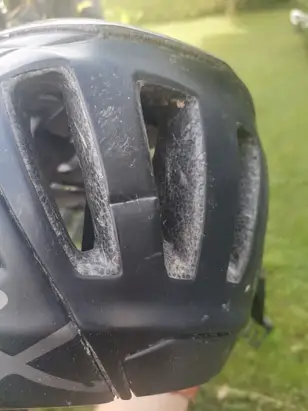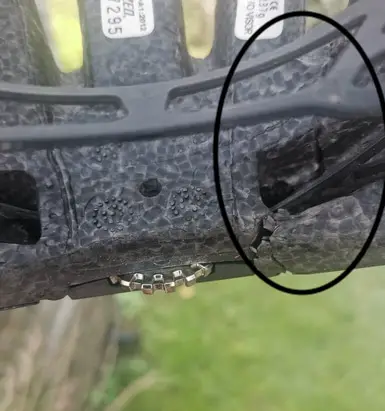Do bike helmets expire, and if so, when? The short answer is yes, bike helmets do expire. The longer answer is that it depends on the material, when it was made, if it has been in a crash, and if there are any cracks or defects showing. It doesn’t matter whether it is a mountain bike helmet, motorcycle helmet or road bike helmet, the rules still apply.
How long should a helmet last?
The Snell Foundation, which determines the safety ratings of bike helmets in the US, came up with the number of 5 years. This is based on the facts that the materials will begin to degrade over time. And that over the 5 years, the helmet will come in contact with chemicals that gradually degrade the helmet. This includes sunlight, sunblock, hair oils etc. Additionally, new technologies in helmets are upgrading every year. So a bike helmet from this year will be safer from the same model helmet in the previous year.
Additionally, this doesn’t mean that any given helmet will last 5 years. There are a number of signs that your helmet should be replaced.
If you crash, replace it!
This is reasonably simple. A helmet with an EPS foam layer is designed for a single crash. EPS is dented permanently and tends to crack or snap under stress, making it unsuitable for multiple impacts.
If your helmet is made of EPP (rather than EPS) foam, it is more durable. It can withstand 2 or 3 impacts. Many newer helmets, particularly full-face mountain bike helmets, have the dual-density foam (EPP and EPS). This includes the likes of the Bell Super DH, Bell Super Air R, and the Fox Rampage Pro Carbon Helmet.
Replacement Deals
Many companies, including the large helmet manufacturer Giro, have replacement deals on their helmets. In some cases you can take back your damaged helmet to get a discount on a newer helmet.
So, if you took back your damaged Giro helmet to Giro, they may discount your next Giro helmet by 30%. This allows you to get an updated bicycle helmet, and the manufacturer gets a second purchase from you. A win-win situation!
How much force is needed to damage the helmet?
It doesn’t take much to damage a bike helmet. Just dropping the helmet on hard ground may cause small cracks which weaken the structural integrity of the helmet.
As stated earlier, EPS foam can only withstand one impact. It does its job well in its first impact but may not do such a great job the next time around. And if the helmet isn’t going to do such a good job the second time, there is next to no point in wearing it!
Therefore, you need to take good care not to drop the helmet and is why you need to replace the helmet after any impact!
Inspect your helmet
You need to inspect your helmet on a regular basis for any cracks or defects which may form over time or following a crash. Another thing to look for is fraying of the chin strap.
A helmet must have a plastic (or carbon) outer shell for it to do its job properly. If your helmet does not have an outer shell protecting the inner foam layer, it will not provide sufficient protection in a crash.
The foam will degrade much faster from UV light, and if the foam is not held strongly together with the outer shell, it will not be able to absorb as much energy in a crash, resulting in more energy directed at the riders skull.
Look for: Any dents or cracks in the outside of the helmet. Any sign of wear is a sign that the strength of the helmet has drastically reduced and will not do its job in protecting your head.

Look for: Visable cracks on the inside of the helmet.

Is the helmet usable?
Before using or purchasing the helmet, check that it meets the minimum safety standards. You can tell if it is, as it will have a sticker on the inside for CPSC, ASTM, or Snell stating the standard it meets. Check that this is the most up to date standard, otherwise, it is likely that it will not be sufficient to protect your head in a crash.
Another thing we personally would look for is the presence of an anti-rotational system such as MIPS. MIPS works as a slip plane which reduces the angular momentum to your head, reducing the chances of brain damage.
Personally, we would never ride without MIPS or similar. And we believe that in the near future, anti-rotational technologies will become compulsory. For the top helmets with MIPS see here.
The final thing to check before deciding whether to replace your helmet or not is checking the fit of the helmet. If it doesn’t fit properly, it is unlikely to protect your head well in a crash. The way that a helmet works is by distributing the energy around the helmet. This is done so that minimal energy is transferred to the riders head.
If the helmet can move on the rider’s head, the energy will not be distributed evenly and can often lead to damage of the neck. If the helmet fits snugly, it will be more comfortable for riding and can reduce the damage to your head.
How long does an unused helmet last for?
If you have purchased a helmet, but never really used it, so it has just been sitting around in the garage for a few years, you are probably wondering if it is still usable. Whether it is usable or not is going to depend on a few things;
- While in storage, has the helmet been exposed to sunlight?
- Has it been in contact with any chemicals, such as sunscreen etc.?
- Has the helmet been stored under pressure? Have you stacked boxes or several layers of clothes on it while it has been in storage?
- Is it older than 7 years?
If you answered yes to any of these, it is time to get a new helmet!
The UV rays can deteriorate the outer shell, making it brittle and comprising the structural integrity of the foam. Similarly, any chemicals it may have been exposed to will also lead to deterioration of the helmet.
If the helmet has been under some weight for some time, gradual pressure cracks may form and weaken the strength of the foam. And if it is an older helmet, it may not meet the most recent safety standards. Additionally, you will be missing out on the latest safety technology which works to help save your life.
Final Thoughts
There is a fair amount of variation between manufacturers on how long a helmet can be used for. Some say between 3-4 years, others say 5-8 years. To be honest, the shorter years seem like a money-making scheme, as most helmets manufactured to meet the safety standards will last the 5 years. Look at what each manufacturer states in their product specifications. But as a rule of thumb, replacement every 5 years is a good idea.
But one thing everyone can agree on is that if a helmet has been in a crash, or dropped onto a hard surface, it needs to be replaced. However, replacing a helmet every few years can be expensive. Some companies will help out by giving you a discount when purchasing another helmet from them.
In all honestly, a helmet is an investment. The helmet is a sacrifice for your head. You pay a reasonably small amount for something that will save your life if you do crash.
Considering the amount of money you pay for a bike and the rest of the kit, the cost of a helmet is minor in comparison. Materials are being manufactured at a lower price as technology improves. This allows the price of helmets to stay relatively constant while the safety features of helmets steadily climb.
A helmet is a good investment, so treat it well, and it will last much longer. Always replace a helmet after a crash, and make sure that it fits well. You do not want to be left wishing you had replaced your helmet after suffering a head injury.

If you are looking to purchase a new mountain bike helmet, check out our buyers guide here.

